

|
| DEUTSCHLAND | GERMANY |
| Bundesland: Baden-Württemberg | |
| Regierungsbezirk: Stuttgart | |
| Stadt: Stuttgart |
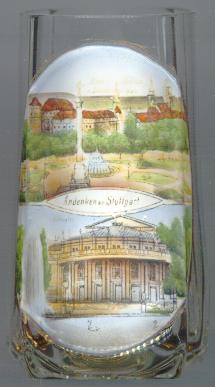 Stuttgart is situated at an elevation of 414 m in a basin formed by the Nesenbach stream, tributaries
of the nearby Neckar river. Stuttgart is the capital of Germany's state of Baden-Württemberg. With a population
of about 590,000 it is the state's largest city. The city of Stuttgart is administered as a district in its own
right; it is also the seat of the administrative region Stuttgart. It is also the seat of both a Protestant and a Catholic
bishop (bishop of Württemberg and bishop of Rottenburg-Stuttgart, respectively). Today, the municipality of Stuttgart is divided
into 5 inner districts (Stuttgart-Mitte, Stuttgart-Nord, Stuttgart-Ost, Stuttgart-Süd, Stuttgart-West) and 18 outer districts
(Bad Cannstatt, Birkach, Botnang, Degerloch, Feuerbach, Hedelfingen, Möhringen, Mühlhausen, Münster,
Obertürkheim, Plieningen, Sillenbuch, Stammheim, Untertürkheim, Vaihingen, Wangen, Weilimdorf and Zuffenhausen).
Stuttgart is situated at an elevation of 414 m in a basin formed by the Nesenbach stream, tributaries
of the nearby Neckar river. Stuttgart is the capital of Germany's state of Baden-Württemberg. With a population
of about 590,000 it is the state's largest city. The city of Stuttgart is administered as a district in its own
right; it is also the seat of the administrative region Stuttgart. It is also the seat of both a Protestant and a Catholic
bishop (bishop of Württemberg and bishop of Rottenburg-Stuttgart, respectively). Today, the municipality of Stuttgart is divided
into 5 inner districts (Stuttgart-Mitte, Stuttgart-Nord, Stuttgart-Ost, Stuttgart-Süd, Stuttgart-West) and 18 outer districts
(Bad Cannstatt, Birkach, Botnang, Degerloch, Feuerbach, Hedelfingen, Möhringen, Mühlhausen, Münster,
Obertürkheim, Plieningen, Sillenbuch, Stammheim, Untertürkheim, Vaihingen, Wangen, Weilimdorf and Zuffenhausen).
The oldest and largest of Stuttgart's boroughs today is Bad Cannstatt which already in Roman times, the 2nd century AD) was an important civitas. Stuttgart itself was only founded in the 10th century by Duke Liudolf of Swabia as a stud farm ('Stute' in German means 'mare', 'Garten' means 'garden'). In the first half of the 13th century, when the area was still in possession of the margraves of Baden, Stuttgart was chartered as a town. By marriage the town later passed to the counts, later dukes, of Württemberg who made it the centre of their territory. Stuttgart became the capital: at first of the County, since 1496 Duchy, 1803 Electorate, 1806 Kingdom, and 1918 Free State of Württemberg.
After World War Württemberg and Baden were occupied by France and the USA. In 1946 three separate states were established: Württemberg-Baden (with Stuttgart as its capital) in the American zone, Baden (with capital at Freiburg im Breisgau) and Württemberg-Hohenzollern (with capital at Tübingen) both in the French zone. In 1952 these three were amalgamated into the federal state of Baden-Württemberg of which Stuttgart again became the capital.
Large parts of the historic city had been severely hit during the war. However, during the reconstruction after the war almost no attempts were made to rebuild the historic cityscape. Moreover, many historic buildings and quarters that had survived were nonetheless torn down to make room for a 'modern' city.
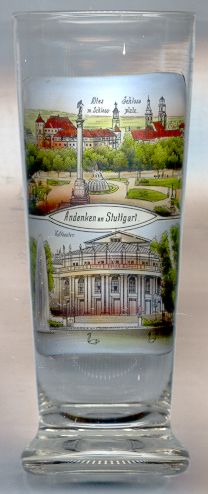
The  Old Castle (Altes Schloss) [left, no. 1134: top picture, background left]
goes back to a moated castle which had been founded around 950 AD. In the 14th century this castle became the residence of the
counts of Württemberg. Between 1553 and 1478 it was rebuilt as a residence castle in Renaissance style. The moats around
the castle were filled in only in the 18th century. In 1931 parts of the castle were destroyed by fire. The restoration works
were still ongoing when the structure was hit by bombs in World War II. The reconstruction lasted until 1969.
The crypt beneath the chapel in the southwest wing holds the tombs of King Karl I of Württemberg and his wife,
Queen Olga. The Old Castle today houses the Württemberg State Museum.
Old Castle (Altes Schloss) [left, no. 1134: top picture, background left]
goes back to a moated castle which had been founded around 950 AD. In the 14th century this castle became the residence of the
counts of Württemberg. Between 1553 and 1478 it was rebuilt as a residence castle in Renaissance style. The moats around
the castle were filled in only in the 18th century. In 1931 parts of the castle were destroyed by fire. The restoration works
were still ongoing when the structure was hit by bombs in World War II. The reconstruction lasted until 1969.
The crypt beneath the chapel in the southwest wing holds the tombs of King Karl I of Württemberg and his wife,
Queen Olga. The Old Castle today houses the Württemberg State Museum.
The  Stiftskirche [left, no. 1134: top picture, background right] is the
church of the Protestant bishop of Württemberg. With its two unequal towers it is the popular landmark of Stuttgart.
The first building period dates from around 1170, the lower parts of the south tower are the only preserved examples of
edifices from the Hohenstaufen period in Stuttgart. The crypt beneath the church holds the tombs of more than one hundred
members of the House of Württemberg. During World War II the church was heavily damaged and after the war was
reconstructed only in simplified forms.
Stiftskirche [left, no. 1134: top picture, background right] is the
church of the Protestant bishop of Württemberg. With its two unequal towers it is the popular landmark of Stuttgart.
The first building period dates from around 1170, the lower parts of the south tower are the only preserved examples of
edifices from the Hohenstaufen period in Stuttgart. The crypt beneath the church holds the tombs of more than one hundred
members of the House of Württemberg. During World War II the church was heavily damaged and after the war was
reconstructed only in simplified forms.
The  Staatstheater (State Theatre) [left, no. 1134: bottom picture]
was built in 1909–1912 as Hoftheater (Court Theatre). The architect was Max Littmann from
Munich. The building, which consisted of an opera and a theatre stage, was put under
monumental protection already in 1924. After World War II only the part that included the large stage (Großes Haus)
remained. The Opera House today has 1,399 seats and houses the opera and the ballet. A new theater, Schauspielhaus, with
851 seats was added in 1959–1962.
Staatstheater (State Theatre) [left, no. 1134: bottom picture]
was built in 1909–1912 as Hoftheater (Court Theatre). The architect was Max Littmann from
Munich. The building, which consisted of an opera and a theatre stage, was put under
monumental protection already in 1924. After World War II only the part that included the large stage (Großes Haus)
remained. The Opera House today has 1,399 seats and houses the opera and the ballet. A new theater, Schauspielhaus, with
851 seats was added in 1959–1962.
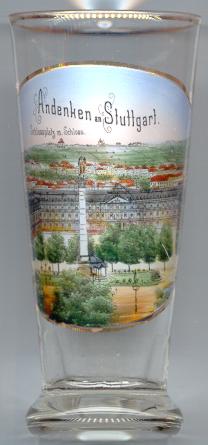
The  New Castle (Neues Schloss) [right, no. 830]
was begun in late Baroque style in 1746 as the new residence for Duke Karl Eugen of Württemberg.
The whole building took until 1807 to be fully completed. It remained the residence of the kings of Württemberg until
the end of the monarchy in 1918. The palace was partly destroyed in World War II. After its reconstruction it is used
today by the government of Baden-Württemberg.
New Castle (Neues Schloss) [right, no. 830]
was begun in late Baroque style in 1746 as the new residence for Duke Karl Eugen of Württemberg.
The whole building took until 1807 to be fully completed. It remained the residence of the kings of Württemberg until
the end of the monarchy in 1918. The palace was partly destroyed in World War II. After its reconstruction it is used
today by the government of Baden-Württemberg.
The  Jubiläumssäule (Jubilee Column) [foreground] on the Schlossplatz
was erected in 1841/1842 on the occasion of the 25th anniversary of the reign of the German Emperor Wilhelm I.
The architect was Johann Michael Knapp. The top of the column carries the statue of 'Concordia'.
The height of the column is 30 m.
Jubiläumssäule (Jubilee Column) [foreground] on the Schlossplatz
was erected in 1841/1842 on the occasion of the 25th anniversary of the reign of the German Emperor Wilhelm I.
The architect was Johann Michael Knapp. The top of the column carries the statue of 'Concordia'.
The height of the column is 30 m.
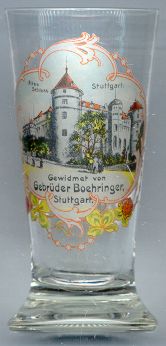 The three glasses no. 1611 [left], no. 1612 [below left] and no. 1613
[below right] are souvenirs made for the Boehringer company. In 1817 Christian Friedrich Boehringer
opened a drug store in Stuttgart. Together with a chemical laboratory this in 1859 became the drug company
"
The three glasses no. 1611 [left], no. 1612 [below left] and no. 1613
[below right] are souvenirs made for the Boehringer company. In 1817 Christian Friedrich Boehringer
opened a drug store in Stuttgart. Together with a chemical laboratory this in 1859 became the drug company
"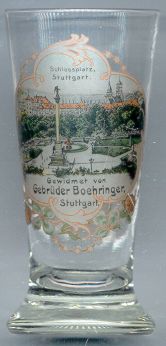
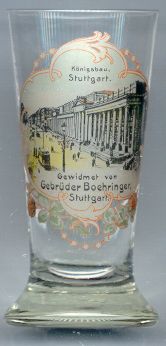
The first two glasses show pictures of the Old Castle and the Schlossplatz, respectively (see above).
Glass no. 1613 [right] shows a picture of the
 Königsbau
Königsbau
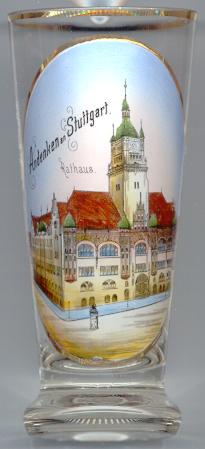
The  New Town Hall (Neues Rathaus) [left, no. 831]
was built in 1901–1905 in place of the old town hall. The architects were Heinrich Jassoy and Johannes Vollmer.
The building was destroyed in 1944; only the characteristic tower survived. The tower was finally broken off when the
present city hall was constructed in 1956/1957.
New Town Hall (Neues Rathaus) [left, no. 831]
was built in 1901–1905 in place of the old town hall. The architects were Heinrich Jassoy and Johannes Vollmer.
The building was destroyed in 1944; only the characteristic tower survived. The tower was finally broken off when the
present city hall was constructed in 1956/1957.
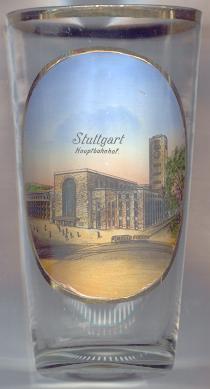
The  Stuttgart Central Station (Hauptbahnhof) [right, no. 767]
was built by the architects Paul Bonatz and Friedrich Eugen Scholer who won the competition for the new station in 1912.
The construction started in 1914 but was prolonged by World War I. The station building was finally opened in 1922
but the construction was not fully completed until 1927. During World War II the building was hit several times
and its reconstruction after the war took several years. The tower of the building has a height of 56 m.
Stuttgart Central Station (Hauptbahnhof) [right, no. 767]
was built by the architects Paul Bonatz and Friedrich Eugen Scholer who won the competition for the new station in 1912.
The construction started in 1914 but was prolonged by World War I. The station building was finally opened in 1922
but the construction was not fully completed until 1927. During World War II the building was hit several times
and its reconstruction after the war took several years. The tower of the building has a height of 56 m.
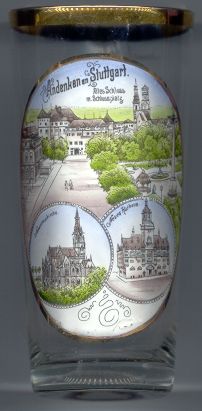
The bottom left picture on glass no. 1973 [left] shows the
 church
church
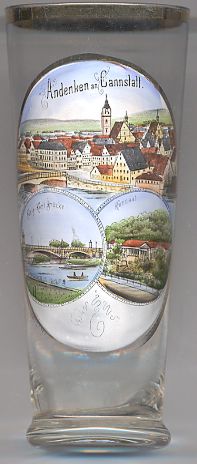 Bad Cannstatt is Stuttgart's most populous city district. It is located on the right, northeast bank of the river Neckar.
The earliest settlements in this place seem to date from the Roman period. This settlement was one of the largest Roman
town in what today is the state of Baden-Württemberg.
The earliest written document mentionting Cannstatt, a deed of donation of the monastery of Sankt Gallen,
dates from around AD 700. Around 708, the name Canstat ad Neccarum is documented.
The Annals of Metz, dating from the
8th century AD, mention the place under the name Condistat, which probably is derived from the Latin word 'conditum' ('founded').
This document refers to the events of 746, the socalled 'Blood-Court of Cannstatt', when Karlmann (Carloman), the son of Karl Martell (Charles Martel),
arrested several thousand noblemen and executed them for high treason, which ended the independence of the duchy of Alemannia.
In 1330 Cannstatt was formerly chartered as a town. The first river harbour of Cannstatt was opened in 1713.
A prosperous period for the town was especially the 18th and 19th century, when Cannstatt became a famous spa town.
In 1905, Stuttgart and Cannstatt were united to become a sigular municipality.
In 1933, the name of Cannstatt was officially modified by the addition of the predicate 'Bad' (spa).
Bad Cannstatt is Stuttgart's most populous city district. It is located on the right, northeast bank of the river Neckar.
The earliest settlements in this place seem to date from the Roman period. This settlement was one of the largest Roman
town in what today is the state of Baden-Württemberg.
The earliest written document mentionting Cannstatt, a deed of donation of the monastery of Sankt Gallen,
dates from around AD 700. Around 708, the name Canstat ad Neccarum is documented.
The Annals of Metz, dating from the
8th century AD, mention the place under the name Condistat, which probably is derived from the Latin word 'conditum' ('founded').
This document refers to the events of 746, the socalled 'Blood-Court of Cannstatt', when Karlmann (Carloman), the son of Karl Martell (Charles Martel),
arrested several thousand noblemen and executed them for high treason, which ended the independence of the duchy of Alemannia.
In 1330 Cannstatt was formerly chartered as a town. The first river harbour of Cannstatt was opened in 1713.
A prosperous period for the town was especially the 18th and 19th century, when Cannstatt became a famous spa town.
In 1905, Stuttgart and Cannstatt were united to become a sigular municipality.
In 1933, the name of Cannstatt was officially modified by the addition of the predicate 'Bad' (spa).
The Protestant  Town Church [top picture: centre background]
was built in 1471–1506 in Gothic style in place of an older church of the late Romanesque period. The church tower at first remained unfinished,
and was completed later, in 1612–1613, by Heinrich Schickhardt in the 'modern' Reaissance style. The original vaulting of the
nave was destroyed in 1788 by lightning during a thunder storm. It was recreated during the 19th century according to old Gothic forms.
Town Church [top picture: centre background]
was built in 1471–1506 in Gothic style in place of an older church of the late Romanesque period. The church tower at first remained unfinished,
and was completed later, in 1612–1613, by Heinrich Schickhardt in the 'modern' Reaissance style. The original vaulting of the
nave was destroyed in 1788 by lightning during a thunder storm. It was recreated during the 19th century according to old Gothic forms.
The bottom left picture on glass no. 2403 shows the
 König-Karl-Brücke
König-Karl-Brücke
The  Kursaal [bottom right]
was built in 1825–1839 by Nikolaus Thouret in Classicist style.
Kursaal [bottom right]
was built in 1825–1839 by Nikolaus Thouret in Classicist style.
![[scale]](lineal.jpg)